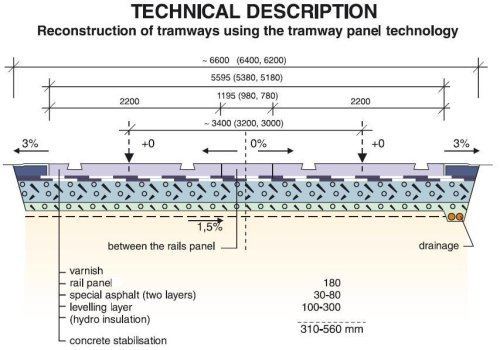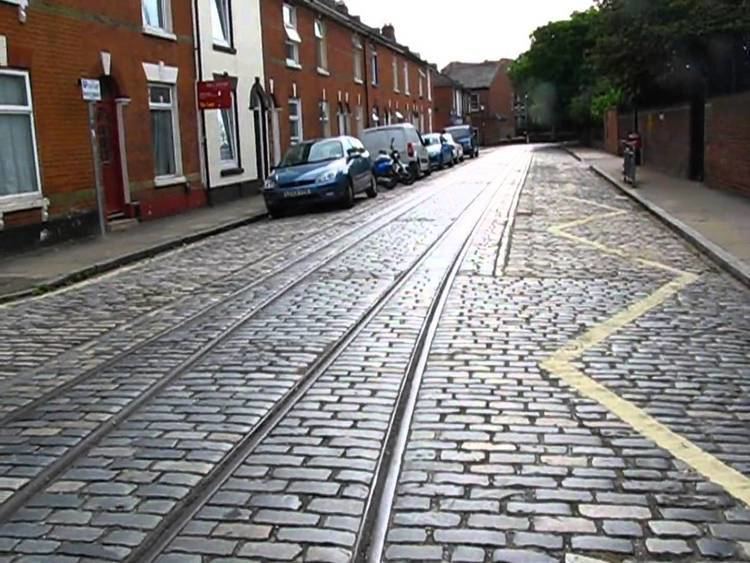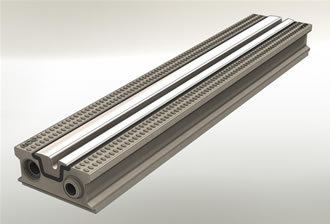 | ||
Tramway track is used on tramways or light rail operations. Grooved rails (or girder rails) are often used to provide a protective flangeway in the trackwork in city streets. Like standard rail tracks, tram tracks consist of two parallel steel rails.
Contents
- History
- Electrification
- Cable haulage
- Conduit and stud systems
- Grooved rail
- Other tram track profiles
- References

Tram rails can be placed on several surfaces, such as with standard rails on sleepers like railway tracks, or with grooved rails on concrete sleepers into street surfaces (pavement) for street running. Another environmentally friendly or ecologically friendly alternative is to lay tracks into grass turf surfaces; this is known as grassed track (or track in a lawn), first used in Liverpool in 1924.

History
The first tramways were laid in 1832 in New York by John Stephenson, to assist horses pulling buses through dirt roads, especially in wet weather when muddy. By laying rails, a horse could easily pull a load of 10 tonnes rather than 1 tonne on a dirt road. The evolution of street tramway tracks paralleled the development from horse power to mechanical, especially electric power. In a dirt road, the rails needed a foundation, usually a mass concrete raft. Highway authorities often made tramway companies pave the rest of the road, usually with granite or similar stone blocks, an extra cost.
The first tramways had a rail projecting above the road surface, or a step set into the road, both of which were apt to catch the narrow tyres of horse-drawn carriages. The invention by Alphonse Loubat in 1852 of grooved rail enabled tramways to be laid without causing a nuisance to other road users, except unsuspecting cyclists, who could get their wheels caught in the groove.
Electrification

Electrification needed other developments, most notably heavier rails to cope with electric tramcars weighing 12 tonnes rather than the 4 tonne horse-drawn variety; switching points, as electric trams could not be pulled onto the correct track by horses; and the need for electrical connections, to provide the return path for the electric current, which was usually supplied through an overhead wire.
Cable haulage

Prior to the universal introduction of electric power, many tramways were cable hauled, with a continuous cable carried in a conduit under the road, and with a slot in the road surface through which the tram could clasp the cable for motion. This system can still be seen in San Francisco in California as well as the system of the Great Orme in Wales. These needed a rather more substantial track formation.
Conduit and stud systems
In some cities where overhead electric cables were deemed intrusive, underground conduits with electrical conductors were used. Examples of this were New York, Washington DC, Paris, London, Brussels and Budapest. The conduit system of electrical power was very expensive to install and maintain, although Washington did not close until 1962. Attempts were made with alternative systems not needing overhead wires. There were many systems of “surface” contact, where studs were set in the road surface, and energised by a passing tram, either mechanically or magnetically to supply power through a skate carried under the tram. Unfortunately these systems all failed due to the problem of reliability and not always turning off after the tram had passed, resulting in the occasional electrocution of horses and dogs. In the last five years a new system of surface contact has been installed in the Bordeaux tramway by Alstom.
Grooved rail
A grooved rail, groove rail, or girder rail is a special rail with a groove designed for tramway or railway track in pavement or grassed surfaces (grassed track or track in a lawn). This was invented in 1852 by Alphonse Loubat, a French inventor who developed improvements in tram and rail equipment, and helped develop tram lines in New York City and Paris.
Other tram track profiles
An alternative to the conventional girder profiled grooved track is the LR55 profile. This is considerably cheaper and easier to install and maintain than conventional girder rail as it requires a smaller footprint foundation and existing utility services need not be disturbed. There is also grooved block rail.
